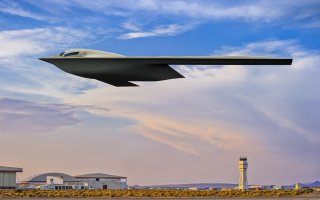U.S. Air Force Says It Needs 'North of 220 Bombers'
Can the current rate of procurement and modernization ensure that the Air Force keeps up with global demands?
Here's What You Need to Know: A new generation of stealth bomber is on the horizon.
The demand for bombers from Air Force Combatant Commanders emerging from key hotspots around the globe continues to exceed available resources, a circumstance which continues to inspire a call from service leaders for more bombers.
Bomber Task Forces, are being stepped up around the world as increasingly vital to deterrence operations in the current threat environment. B-1 bombers are arriving in India and Norway to beef up patrols in the Indo Pacific as well as the Arctic. In addition, B-2 bombers arrivals in Portugal plan to contribute to increased bomber patrols on the European continent. Moreover, B-52 bombers are increasingly being armed with newer, more capable weapons to keep potential adversaries at risk. Simply put, there does seem to be an emerging consensus among Pentagon leaders that more bombers and more Bomber Task Force patrols are needed.
“We need North of 220 bombers,” Gen. Tim Ray, Commander, Air Force Global Strike Command, told reporters at the 2021 Air Force Association Symposium.
The path toward this number, Ray explained, is varied, challenged and complex as it involves a crucial balancing act between the introduction of new platforms such as the B-21 alongside concurrent efforts to extend the effective operational life of several upgraded existing weapons systems.
“The road map is well thought out. We need more B-21 and also need to make sure the B-2 is viable until the B-21 comes in sufficient numbers. We are also re-engining the B-52 and bringing on new radar and cruise missiles, a process being expedited through digital prototyping,” Ray said.
As for the sustainment front, there are ambitious and productive efforts going on with respect to the B-2, B-1 and B-52, as each of these planes are entirely different than they were at their inception. The B-52, for example, has new communications technology enabling real-time, in-flight intelligence data sharing, a massively increased bomb-carrying capability with an internal weapons bay and an ability to accommodate new weapons such as cruise missiles and hypersonics.
The airframes are still believed to be viable for many years into the future, and there is the important re-engining process, which Ray mentioned. New secure radio connectivity on the B-52, for example, enables pilots to receive upgraded targeting and mission details as new intelligence emerges, as opposed to being bound by pre-planned and pre-loaded targeting and mission specifics. As for the B-52 re-engining, Ray explained that digital engineering is allowing the Air Force to “accelerate” the process.
The B-1 is on what could be called a two-fold trajectory as it is both phasing out for retirement and divestment yet also being upgraded to sustain effective functionality for years to come until new B-21 bombers arrive in sufficient numbers. The B-2 Spirit bomber, now thirty-years old, is fast becoming an entirely new platform with improved weapons, sensors and computing.
Despite the continued promise and viability of many of these decades-old platforms, there certainly may be an emerging, if not already existent, discussion about just what kinds of future bombers might need to be added to the force. Will a new B-52-like platform eventually be needed? It would be difficult to envision a scenario where the answer was not “yes.”
The B-21 is arriving, as a new generation of stealth bomber, for specific high-value missions unique to its unprecedented capabilities, yet there may be another sphere of missions for which new bomber platforms might be needed. When might this begin to materialize? Will there be a budget for these kinds of innovations? Expect many upcoming discussions on these topics.
Kris Osborn is the defense editor for the National Interest. Osborn previously served at the Pentagon as a Highly Qualified Expert with the Office of the Assistant Secretary of the Army—Acquisition, Logistics & Technology. Osborn has also worked as an anchor and on-air military specialist at national TV networks. He has appeared as a guest military expert on Fox News, MSNBC, The Military Channel, and The History Channel. He also has a Masters Degree in Comparative Literature from Columbia University.
This article first appeared in March 2021.
Image: U.S. Air Force photo courtesy of Northrop Grumman.

